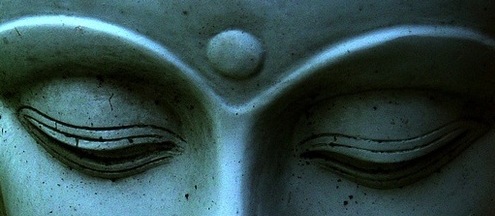In order to understand something of the nature of Kundalini energy, it is necessary first to understand something of the paradigm or world-view which supports this rather unusual and profound phenomenon. The following ideas have been taken from both ancient Hindu philosophy and the writings of Gopi Krishna.
Western scientific thought, despite the discoveries of physics in the last 100 years, is rooted in the idea that what we perceive with our senses is ‘real’ and external to us and that our consciousness or subjective experience is simply an epi-phenomenon, or consequence, of the chemical activity of the brain.
The esoteric systems of India, on the other hand, view consciousness as the ultimate or paramount reality. This supreme reality, or Brahman as it is called, is said to be beyond the capacity of our limited human mind to perceive directly, as it is infinite, formless, timeless, and has no physical attributes by which we can comprehend it directly. Our individual awareness is said to be like a drop in this infinite ocean and the physical world that we perceive as external to us is held to be a projection of this individual drop of awareness.
This constitutes a complete reversal of the western, scientific, world-view. The reason that we do not experience reality in this way, at our current level of perception, is due to the limitations placed on our consciousness by the brain and nervous system of our body, through which it functions. The goal of evolution, or at least the next step to which we are evolving, would be the enhancement of our perceptive faculties to the point where this new world-picture is a day-to-day reality.
Since our world view, physical existence, and mental process are rooted in dualism, i.e. good/bad; up/down; male/female; hot/cold, positive/negative, etc., our minds are more comfortable conceptualizing this ultimate reality in dualistic terms. They have been defined by Hindu philosophical thought as Supreme Consciousness and an Infinite Creative Energy, or Shiva and Shakti.
From this Shakti, at one level, the physical universe, consisting of matter and the four known forces, is manifested. At another level, it manifests as prana, or the animating principle which gives life to all sentient things. This animating principle, referred to at this level as Kundalini, is most evident in the process of conception, development of the embryo, and birth where, after this process is complete and a new individual is born, it is said to go into a quiescent or dormant state at the base of the spine where it maintains the basic life processes of the body.
As the microcosm is a reflection of the macrocosm, so the universal principles of Shiva and Shakti are present in the human body. Shiva is held to be the conscious principle centered in the head, while Shakti (referred to as Kundalini energy) lies in a quiescent state at the base of the spine.
As a consequence of our lifestyle, spiritual practices, heredity, and other factors, Kundalini can become reactivated and the same processes which built our body in the womb now begin to function again, but in a different manner. They now work to refashion the brain, organs, and nervous system so that a more elevated form of consciousness is possible. The ultimate, although rarely attained, goal of Kundalini is to permanently transform our being so that a new perceptive faculty emerges by which we can experience reality directly as consciousness. In most cases, however, the individual eventually becomes more creative, psychically sensitive, aware of who they are, and better adjusted to their environment, with an enhanced faith in the Divine.
The effects of this activity are many and varied and can extend to all aspects of our being–physical, mental, emotional, and spiritual. They can range from being barely noticeable to totally overwhelming. They can vary widely in duration and ultimate effect from individual to individual as a great many factors are involved. To someone who is not familiar with what is happening and why, these processes can be quite disturbing and even terrifying. Attempts to obtain guidance and support from medical and health care professionals and religious institutions are often found to be frustrating and even counter-productive, due to the general lack of good information on this subject.
But it must always be kept in mind that the process is a natural one, as much a part of our being as conception and birth, and although it may sometimes be difficult, it is attempting to bring about change of a very positive nature in us to advance the level of our evolution both as individuals and as a species.
Kundalini & The Awakening Of Spirit
As humanity accelerates towards the millennium, more and more people are reporting spiritual experiences and opening into awareness that physical reality is only a fraction of all that is.
How does spiritual emergence begin?
No one knows for certain just what kick starts the unfolding of spiritual potential. For some, spiritual emergence is a gentle and integrated process which develops as a natural consequence of many years dedicated to service and prayer or meditation under the guidance of a teacher or guru. Others may experience a more abrupt awakening, possible due to practices which awaken transformative energy before the person has done the necessary groundwork.
It is thought that practices such as yoga, bioenergetics, polarity work or breathwork cause the awakening of Kundalini energy which heralds the transformation of spiritual potential. Kundalini is the Hindu word for the sacred, transformative energy that awakens consciousness. According to esoteric literature, this energy has been coiled at the base of the spine in a latent form since birth, awaiting the stimulus to unfold its potential.
As this energy becomes active, it is usually sensed as a vibrational or energetic force in the body, together with a strong sense of spirit. Its movement may be experienced as a rushing, outpouring, a steady streaming up the spine, or a slowly coiling spiral motion.
Another common catalyst seems to be intense physical or emotional distress. As people confront the limits of their endurance and come face to face with death, they will often move into non ordinary or transpersonal states of consciousness. Thus experiences with natural disasters, near death experiences, or life transitions such as pregnancy, midlife or separation, may be emotionally tense situations which can lead to spiritual awakening.
Regardless of the specifics of each individual’s experience, the Kundalini awakening heralds a great period of change in a person’s life.
What is spiritual emergency?
When spiritual seekers or even those who do not consider themselves to be on a spiritual path find themselves experiencing levels of awareness or energy transformation that they are unable to handle or for which they have no reference, then the result can be a state of emergency. In this state, a person feels highly vulnerable and oversensitive to incoming stimuli. Typically they feel overwhelmed, fragmented, fearful, confused and disoriented. With their absorption in inner processes, they may not be able to look after even basic self care.
All these situations can be bewildering and frightening, and at these times these people need support and reassurance as they undergo their transformations. The spiritual emergency network in the US seeks to network people and provide information to facilitate a more gentle emergence of spiritual potentials. The network is intended to put people in touch with others who have undergone similar experiences, or with counsellors who are aware of spiritual dimensions of reality.
The Symptoms Of Kundalini Awakening
While the awakening Kundalini may be a dramatic experience, the resultant shift in consciousness may be accompanied by years of physical and psychological upheavals. The process of Kundalini awakening can vary greatly from person to person. Some have intense physical symptoms, while others experience mainly emotional or psychological symptoms. It is as if the new energy invites a spring cleaning throughout the entire system, with unresolved physical or emotional conditions coming up for resolution and release. The life transforming changes which accompany a Kundalini awakening cover the entire physiological, emotional, mental and spiritual spectrum.
Greenwell (1990) has noted seven categories of symptoms which have been observed during Kundalini awakening.
1. Pranic movements or kriyas
Prana is the Hindu word for vital energy. Thus as intense energy moves through the body and clears out physiological blocks, a person may experience intense involuntary, jerking movements of the body, including shaking, vibrations, spasm and contraction. As deeply held armouring and blockages to the smooth flow of energy are released, the person may re-access memories and emotions associated with past trauma and injury.
2. Yogic Phenomena
Some people find themselves performing yogic postures or hand mudra gestures which they have never learned or could not do in a normal state of consciousness. Similarly, they may produce Sanskrit words or sounds, or have an awareness of inner music or sound, mantras or tones. Unusual breathing patterns may appear with either very rapid or slow, shallow breathing. Some people may not breathe at all for extended periods.
3. Physiological Symptoms
A Kundalini awakening often generates unusual physiological activity as intense movement of energy releases toxins in the body. Symptoms include apparent heart problems, pains in head and spine, gastrointestinal disturbances and nervous problems. Internal sensations have been reported as sensations of burning, oversensitivity to sensory input, hyperactivity or lethargy, great variations in sexual desire and even spontaneous orgasm. Symptoms can be erratic, coming and going without provocation, but are generally unresponsive to medical treatment.
4. Psychological Upheaval
Spiritual awakening offers a direct challenge to the primacy of ego consciousness and the myth of separation. It brings with it a challenge to move beyond the unconscious responses ruled by drives and instincts and remove ego consciousness from the centre stage of the psyche. It comes as no surprise that such a challenge produces a period of confusion and unbalance. People find themselves beset by inexplicable emotional states as they move to clear out unresolved issues. The emotional roller coaster may swing from feelings of anxiety, guilt and depression, through to compassion, love and joy, with accompanying bouts of uncontrollable weeping.
5. Extra Sensory Experiences
As perception expands outside of consensus reality, people experience atypical visual phenomena, including visions of lights, symbols, entities, or review of past life experiences. Auditory input may include hearing voices, music, inner sounds or mantras. Even the olfactory system may be stimulated with perception of scents of sandalwood, rose or incense. There may also be disruption of the proprioceptive system, with losing a sense of self as a body, or feeling bigger than the body, or out of the body, with the resulting confusion and disorientation.
6. Psychic Phenomena
With the opening up of psychic abilities, a person may experience precognition, telepathy, psychokinesis, awareness of auras and healing abilities.
7. Mystical States of Consciousness
A person may shift into altered states of consciousness where they directly perceive the unity underlying the world of separation and experience a deep peace and serenity with a profound knowing of wisdom.
In some cases, the state of emergency due to psychological upheaval is so acute that it resembles a psychotic episode. Many clinicians still regard phenomena associated with spiritual emergence as indicative of pathology because the signs are so easily confused with the indicators of psychosis, mania, depression, schizophrenia or borderline personality disorder. Many people undergoing spiritual emergency are misdiagnosed and treated with suppressive medication which further complicates their process.
What can be done to support a Kundalini awakening?
When Kundalini awakening happens to people who are not on a spiritual path or who have no context or framework to understand the bewildering upheaval of mind, body and spirit, the experience can leave them fragile and fragmented. As the Kundalini process involves a redefinition and reintegration of self, it adds extra pressure when health professionals or significant others wish to suppress the transformation and insist that the person conforms to old ways of being in the world.
Of greatest benefit is a supportive framework which can allow people to make sense of the intricate connection between spirit and the movement of physical energy in the body, rather than fearing they are going insane. It is more empowering to understand that Kundalini awakening is a process which taps into the blueprint for higher consciousness which is latent within every human. While the enormous changes associated with a spiritual awakening may demand psychological and social adjustments, they are not in themselves necessarily indicative of illness. Communication and connection with others who can provide support and a meaningful context for understanding the process reduces the isolation and overwhelm and can help to minimise the disturbance. Someone who has the personal qualities of creative adaptation to change and a flexible mental framework is more likely to weather the changes with grace and style than someone who is rigid in their beliefs and world view.
Humanity’s Wake Up Call
Usually the awakening of Kundalini was a process which only occurred after years of spiritual practice and meditation. Yet increasingly, the Kundalini experience is being reported among people who are not undertaking spiritual practices. Since 1993, when Shared Transformation, an American journal for connecting spiritual awakeners first began, it has been contacted by over 700 people in the throes of spontaneous Kundalini arousal (Collie & Kress,1995). These increased reports of spontaneous Kundalini awakening at this time of planetary upheaval may be indicative of a larger purpose at work, the beginning of a planetary wake up call. Anyone who is on a spiritual path, or engaging in practices which change body energies, such as meditation, yogic practices, breathwork, rebirthing or polarity balancing, may find they begin to resonate with the changing energies at this time and that they begin their own Kundalini awakening process.
Is Kundalini awakening the same as enlightenment?
It is important not to confuse Kundalini awakening with enlightenment. Enlightenment rarely results from a single encounter with the numinous. It is more as if the energetic awakening initiates an expansion in consciousness which sets the scene for a progression of many experiences with transpersonal states of consciousness. The intensity and duration of each of glimpse varies with our readiness to contain and integrate them. Thus the Kundalini awakening is not an end point in itself, but the beginning of a transformation of consciousness which expands our capacity to KNOW the infinite. Spiritual emergence often includes expanded perceptual abilities, increased energy, creative expression and a dedication to being of service for the greater good.
Author: Karin Hannigan
http://www.spiritual.com.au




 Tantric Goddess Training & the Arts of Sacred Sexuality is starts late spring 2014 in for the cities listed below.
Tantric Goddess Training & the Arts of Sacred Sexuality is starts late spring 2014 in for the cities listed below.